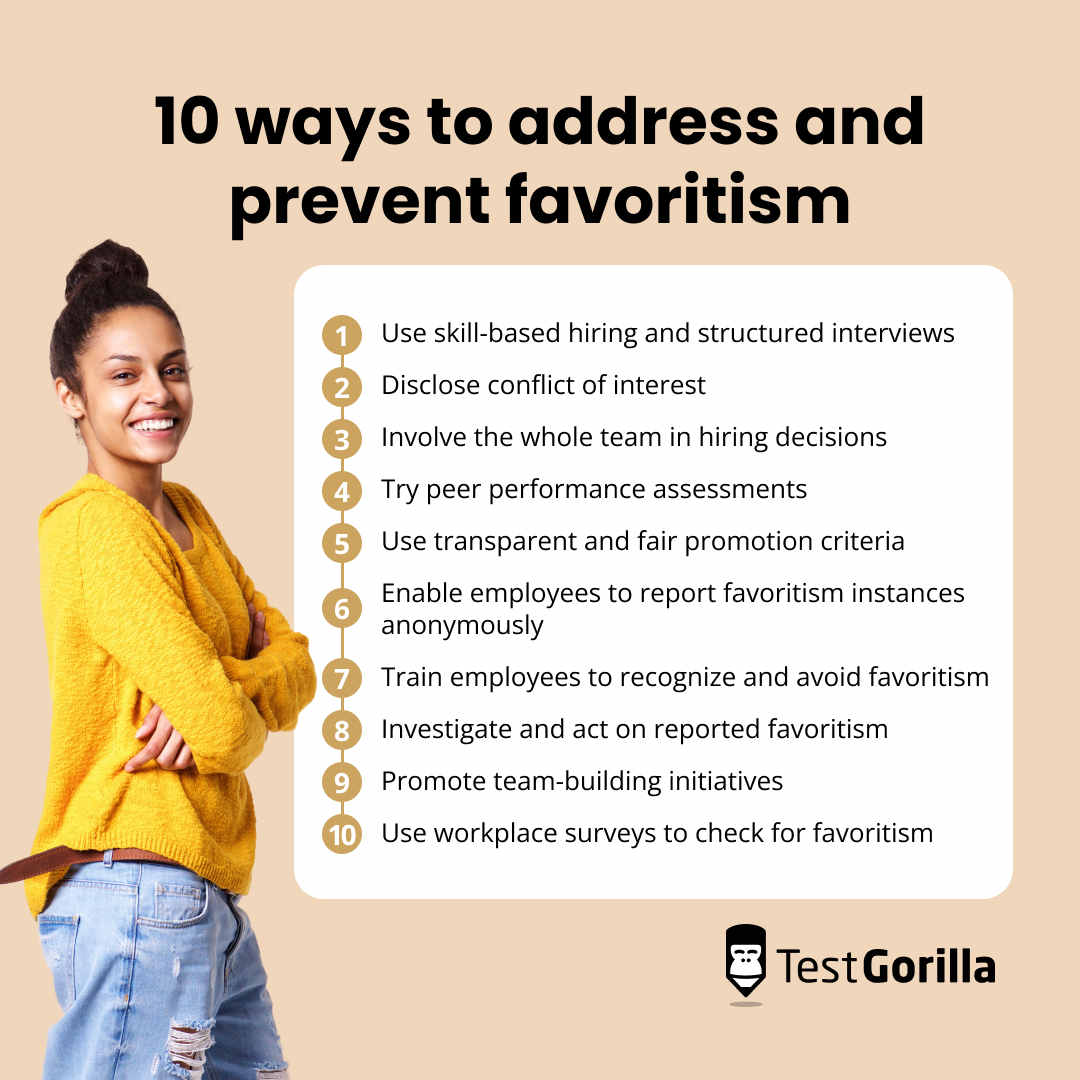Imagine that your boss puts a salesperson forward for a promotion.
The salesperson doesn’t have the best performance report compared to other promotion candidates, but they regularly hang out with your boss outside of work.
Instances of favoritism like this can affect workplace morale and productivity because employees feel that their efforts are unrecognized and that there’s no point in doing their best.
Research shows that 56% of bosses have a favorite in mind before the formal promotion process begins, and 75% of respondents witnessed favoritism.[1]
Although it’s challenging to avoid preferring the colleagues you get on well with, it’s essential to prevent favoritism from harming your company’s culture.
Using objective evaluation tools, like skills tests, to assess your employees can make your hiring and promotion processes fair and transparent.
In this article, we discuss favoritism in the workplace, its effects, and 10 ways to prevent it.
Table of contents
What is favoritism in the workplace?
Favoritism in the workplace is showing special treatment to employees based on subjective factors outside of their performance.
In terms of employment law, the US Equal Opportunity Commission (EEOC) says that unless favoritism manifests as illegal discrimination based on race, gender, or ability,
workplace favoritism can’t be punished with legal action.
Because of that, it’s tough for human resources teams and affected employees to report and solve workplace favoritism.
It’s important to remember that favoritism doesn’t only occur from the top down. It can also happen when coworkers choose to only work with their friends instead of showing fairness to everyone on their team.
Like other forms of discrimination, favoritism can result from a power dynamic and unconscious bias in your hiring practices.
12 common examples of favoritism in the workplace
Favoritism is, unfortunately, human nature – we can’t help but gravitate toward the coworkers we like and get along well with.
However, if left unchecked, these situations can devolve into harmful circumstances where employees experience exclusion and, in extreme cases, bullying.
Here are some common signs of favoritism and cliques in the workplace.
Type of favoritism | What it looks like |
Promotion and career advancement | - More promotion opportunities and guidance - More vacation time and paid time off - More likely to be referred for internal roles |
Assignments and projects | - Special assignments - Extra assistance and extra time with projects - Information silos, which exclude unfavored coworkers from knowledge sharing |
Double standards | - Favorites get away with absenteeism, poor performance, or tardiness - Selective feedback - Taking sides without objectivity |
Unfair treatment, recognition, and support | - Unfair decisions about raises and benefits - Unbalanced task distribution - Scapegoating and unfair reprimands |
The broader effects of favoritism in the workplace
Favoritism doesn’t just affect the employee morale and engagement of those directly involved.
It affects the entire organization because it signals that objective decision-making isn’t a priority.
Let’s look at the broader effects of favoritism in the workplace.
High staff turnover
Employees who feel their efforts are less likely to be noticed and rewarded may start looking for another job. Research shows that 57% of employees leave their jobs because of their bosses.
Bosses displaying overt favoritism may be only one reason these workers leave the company.
When only favored employees have an advancement path in the company, and who they know trumps merit and performance, other workers become demotivated.
Opportunities to grow and develop are top factors people want in their jobs, alongside better pay and wellbeing.
More than 50% of employees say they are actively or passively looking for a job, so not providing paths to advancement to all employees can be costly.
To avoid that, ensure your job descriptions are clear, transparent, and objective, and career development plans only consider performance and skill sets.
Your employees appreciate the transparency of the process, and your managers can make objective promotion decisions.
Lower morale and demotivated employees
When employees see their colleagues get promotions or receive extra perks for unjustifiable reasons, their morale and motivation can take a hit.
Favoritism signals that an employee’s performance is less important than having a personal relationship with another worker.
Workers don’t see the point of a strong work ethic when leaders ignore performance and promote based on personal preferences.
According to the same Gallup study above, 41% of employees feel that changing the engagement or culture of their current employers would make them great workplaces.
Moreover, favoritism is the opposite of professionalism.
Employees expect their wages and promotions to be decided based on their overall performance, contributions, and skills. When this happens, they are motivated, satisfied with their jobs, and loyal to the company.[2]
The opposite happens when favoritism runs rampant.
Therefore, not using objective factors to guide your promotion and raise decisions results in a vicious circle that begets disenfranchised employees, stagnation, and a toxic culture.
A toxic culture
Favoritism can create a toxic culture when senior employees hire and promote people they get along with to create a comfortable environment.
This can make the environment favorable for these leaders, but it demotivates the rest of the team and promotes a fundamental lack of trust between employees and senior leadership.
This type of environment can cause other forms of discrimination. Because favored employees can get away with things other employees get reprimanded for, they can bully coworkers without punishment.
Bullying, even when it presents as a subtle form of gaslighting, has severe consequences for mental health in the workplace.
When favoritism excludes workers or groups from decision-making or undermines their work, they can experience mood changes, panic attacks, high stress levels, anxiety, and depression.[3]
To avoid favoritism turning your culture toxic, you can:
Design a code of conduct that outlines expectations for fair treatment for all workers
Train managers to recognize and prevent favoritism
Encourage employees to speak up when they experience favoritism
Low productivity
Productivity suffers when employees are demotivated and stop working efficiently.
Demotivated employees quickly become disengaged from your company and culture. A lack of engagement can hurt your productivity and profitability.
Engaged employees have 18% more productivity and 23% more profitability than their disengaged counterparts.
Favoritism can stem from one senior manager but could also result from unconscious bias at the company level, which is impossible to eliminate.
However, to encourage objectivity and reduce favoritism and bias, ensure your processes support objective decision-making, collaboration, feedback, and transparency in all interactions between workers and management.
10 solutions to favoritism in the workplace for leaders and HR departments
Now that we’ve seen why favoritism is so harmful to workplace culture, let’s look at solutions.
Below, we offer 10 actionable ways to address and prevent favoritism and create happier, more productive, and more cohesive workplaces.
10 solutions to favoritism: The summary
Solution | What it does |
1. Use skill-based hiring and structured interviews | Minimizes favoritism because it focuses on objective skills rather than biased perceptions |
2. Disclose conflict of interest | Reduces the chance that personal obligations interfere with objective decision-making |
3. Involve the whole team in hiring decisions | Make job descriptions clearer and directly tied to skills and performance targets |
4. Try peer performance assessments | Lets other employees weigh in on their peer’s performance, adding fairness and objectivity to performance assessments |
5. Use transparent and fair promotion criteria | Ensures that only employees who meet objective performance requirements get promoted |
6. Enable employees to report favoritism instances anonymously | Gives employees tools to report favoritism without exposing themselves or fearing retaliation |
7. Train employees to recognize and avoid favoritism and prevent workplace conflict | Decreases the chances of your culture turning toxic and promoting strife in the workplace |
8. Investigate and act on reported favoritism | Shows workers who engage in favoritism that they are going to face consequences |
9. Promote team-building initiatives | Encourages employees to trust their managers and helps managers understand how their actions impact their team |
10. Use workplace surveys to check for favoritism | Enables HR departments to use answers to quantitative and qualitative questions to formulate plans and initiatives to prevent favoritism |
1. Use skill-based hiring and structured interviews
Skill-based hiring relies on testing the hard and soft skills required by each position instead of screening resumes and using culture fit.
It reduces bias in hiring and prevents hiring candidates who “look good” on paper but don’t add to the culture.
It minimizes favoritism because it focuses on objective skills rather than subjective factors like perception and reputation, which bias external and internal hiring.
Structured interviews are a form of talent assessment that can root out favoritism at the hiring level.
The recruiter has to ask candidates the same questions, which doesn’t let them bond with them based on subjective preferences.
On the other hand, unstructured interviews encourage bias because the two parties can bond over commonalities. Using them as a “beer test,” the hiring manager is more likely to pick someone they’d want to hang out with outside of work.
As a result, it’s easier to hire the candidate they like than a quality candidate. Mis-hires go beyond wasting resources on people who don’t perform. They generate turnover and cause skills gaps.
Talent assessments discourage favoritism and let objectivity rule the hiring and promotion process. They mitigate the effect of bias in hiring and reduce mis-hires by 88%.
2. Disclose conflict of interest
Conflict of interest happens when someone’s responsibilities or loyalties to family and friends prevent them from working and leading objectively.
It ties into favoritism when a person in a decision-making role lets personal responsibilities and loyalties color their decision-making in favor of an employee.
Disclosing any potential conflict of interest can reduce the chances of favoritism taking hold.
Using skills-based hiring can prevent favoritism because you don’t rely only on referrals or networks for your hiring needs.
A common form of favoritism caused by conflict of interest is nepotism, where senior leaders give preferential treatment to friends and family members without objective performance metrics.
A conflict of interest policy, a guide on resolving potential conflicts of interest, and disciplinary actions can prevent this situation.
For example, suppose a manager discloses that a family member has applied with your company.
A process for mitigating this conflict of interest could be ensuring the family member doesn’t work under the manager’s direct supervision.
3. Involve the whole team in hiring decisions
An easy way for favoritism to affect hiring decisions is when a senior employee with no direct understanding of the context of the role you’re hiring for is the only voice in the room.
Ensure that a single senior manager cannot monopolize the process.
Not all roles allow for a democratic hiring process that includes representation for the entire team. However, you should involve more decision-makers, especially direct supervisors.
In addition to testing for skills, recognizing your team’s needs by including them in hiring decisions can make your hiring fair and objective.
When you involve the team in hiring decisions, you also gain insights into facets of the role that management may need to become more familiar with.
Use this information when you write your job descriptions to ensure your decision-makers understand the role’s requirements from the perspective of your potential hire’s coworkers.
For example, when hiring a manager, consulting the team and including a peer at the interview stage can ensure that you hire someone who:
Treats everyone fairly
Delegates effectively
Keeps employees engaged
Creates an inclusive workplace
4. Try peer performance assessments
One disadvantage of performance assessments is that the manager who conducts them might be biased about the person they’re evaluating.
It’s a form of favoritism, but the manager may not consciously try to favor a particular employee.
They may be only looking at hard skills or metrics or may be overwhelmed by the size of their team. Likewise, assessing new employees may be difficult if the manager doesn’t have an objective view of them.
A peer review module during performance assessments can help managers better understand employees' unique approaches to getting the job done.
Ensure that a different peer assesses each employee monthly to discourage lateral favoritism, which happens when workplace friends evaluate each other.
The process becomes skills-based and fairer, eliminating the chance that a manager’s preferences or biases affect promotion decisions.
To complete a skills-based peer assessment, you need precise guidelines. They include:
Defining the skills needed for each role
Creating role-specific talent assessments
Encouraging self-assessment
Incorporating peer feedback
Encourage everyone to evaluate the guidelines and criteria you use in the assessment to ensure they are objective.
Skill-based performance reviews encourage objective decision-making, which is one way to combat favoritism.
5. Use transparent and fair promotion criteria
Clear criteria for each promotion ensure that only employees who meet performance requirements get promoted.
Promotion criteria should include an employee’s performance and measurable effect on the company.
If you tested their skill sets regularly throughout employment, you have measurable criteria for employee promotions rather than arbitrary factors like a manager’s opinion of them and their work.
Use benchmarks and guidelines to develop a promotion policy and clarify all the criteria used to promote the employee.
Also consider:
The type of promotion
Who is eligible
Who can verify the employee’s skills
Using a promotion policy reduces favoritism and promotes inclusion and equity because all employees understand what you require of them.[4]
6. Enable employees to report favoritism instances anonymously
Because favoritism often occurs at the management level, employees may be wary of reporting it to human resources.
You should encourage them to report favoritism whenever it occurs and make it easy for them by enabling them to do it anonymously.
Use anonymous reporting tools, like AllVoices, to let your employees report favoritism, harassment, and bias without worrying about retaliation and losing their jobs.
These tools let team members send encrypted reports from their phones with no identifying information.
Anonymous reporting enables you to check if favoritism occurs in the workplace and deal with it.
7. Train employees to recognize and avoid favoritism and prevent workplace conflict
Use professional development programs to encourage employees to show each other mutual respect and prevent favoritism and workplace conflict.
Teach employees the differences between healthy workplace friendship and prioritizing favorite employees in a way that discriminates against others.
Healthy recognition is based on job performance. Favoritism, on the other hand, is fed by personal relationships and preferences.
If your culture is already affected by workplace negativity, you can invest in training and professional development to show your staff you value them.
Upskilling and reskilling offer them career growth and reassure them you value their contribution and skill sets.
Healthy ways to prevent and resolve workplace conflict include:
Keeping open communication channels
Making it easy to make formal complaints
Deciding on preventative strategies
Focusing on common goals to achieve a fair resolution
8. Investigate and act on reported favoritism
If you receive many anonymous complaints of favoritism or have a formal complaint about it, you should acknowledge the problem and act on it.
Let’s say that your employees are complaining about your receptionist.
She seems to prioritize certain employees’ mail and phone reminders over others. She also gives extra attention to coworkers who she knows outside of work.
Meanwhile, she doesn’t notify other team members about inquiries or missed calls. It has caused them delays and even cost them clients.
To address the problem, follow the steps below.
An initial 1:1 meeting: Explain what her coworkers experience as a result of her behavior and give her the chance to share her side of the story
Explaining the harms of her behavior: In this instance, it causes delays to important projects and losing clients
Offering her healthy alternatives: Reminders to treat everyone fairly, like prioritizing all employees’ calls
Monitoring her approach: Ask for feedback from her coworkers in the weeks that follow your meeting
Offering reminders: Have follow-up meetings to discuss any instances of favoritism that reoccur
Throughout the process, remember that not everyone who shows favoritism knows they’re doing it until they learn what it is.
For example, your receptionist may not be aware that her actions are affecting the performance of her coworkers and their ability to retain clients.
Therefore, to prevent favoritism, you should show those who engage in it that they will face consequences without making them feel punished.
9. Promote team-building initiatives
Team building can encourage people to work with new coworkers and promote a stronger alignment with your work culture and better conflict resolution.
It discourages favoritism by encouraging employees to trust their managers and helping managers understand how their actions impact their team.
Team-building initiatives can include in-person or remote games or activities that encourage employees to work together and collaborate to solve problems while having fun.
Some ideas of team-building activities that discourage favoritism include:
Hosting a hackathon: Lets technical teams discover their coworkers’ strengths and skills they may not know about
Making a compliment circle: Gives workers a different view of their teammates by making them concentrate on their positive qualities
Healthy debates: Enable employees to interact with each other and learn to respect opposing viewpoints and feedback
Besides their obvious benefits in reducing favoritism, team-building activities can strengthen team identity and employee appreciation. A happy team can also increase your brand awareness.
10. Use workplace surveys to check for favoritism
Make it clear that your company does not tolerate favoritism and use surveys to determine whether your employees have experienced it.
An employee satisfaction survey can measure employee engagement or how happy your employees are about how your company treats them.
To discover whether your employees are committed and motivated, have job satisfaction, and are happy with their career development opportunities, ask quantitative and qualitative questions that check for favoritism.
Quantitative questions | Qualitative questions |
Do you feel compensated fairly? | Are your opinions heard and valued by your team? |
On a scale of one to 10, how likely are you to recommend our company as an excellent employer? | What are the current career paths for you at this organization? |
How many learning opportunities have you received from your job in the past six months? | What type of feedback do you receive from your manager? |
Surveys give your employees the voice to speak up if they experience favoritism and other negative treatment at work. They also help you identify what works and change behaviors that don’t.
How to know you’re on the right track: 6 metrics for tracking your efforts
Preventing favoritism is an ongoing effort. However, once you apply your fixes, you need measurable goals to see what’s working and what isn’t.
Below, we look at six ways in which you can measure whether your solutions are working.
1. Employee turnover rate
We’ve already explored how favoritism can lead to high turnover rates if employees disengage.
Reducing employee turnover can indicate that your measures to prevent favoritism are working.
Turnover rates vary by industry, so research the numbers that apply to your business.
However, low engagement can cause turnover rates that are 18% to 43% higher than those of high-engagement teams.[5] Favoritism is a major cause of low engagement and morale.
Minimizing favoritism should reduce employee turnover rates and improve retention.
2. Complaint resolution time
Tracking complaint resolution time tells you whether your processes are efficient and promptly address your employees’ complaints.
The longer it takes to resolve complaints, the more employees become demotivated and suspect their complaints are not taken seriously.
On average, companies take 25-30 days to resolve incidents of favoritism.[6]
It can take even longer to investigate thoroughly, but employees may become anxious and wonder if their employer cares about their poor experience.
Improving complaint resolution time can reduce favoritism faster and get your culture on the right track.
It also shows your employees you hear and care about their complaints.
3. Employee satisfaction surveys
Use employee satisfaction surveys to get tangible data about your employees’ experiences with favoritism at work.
Use the data from your surveys to create actionable plans to address favoritism, satisfaction, and morale, which usually take a hit when favoritism is in play.
You should also periodically check to see whether your recognition programs work by giving a nod to those employees who are less likely to get noticed because they primarily work independently.
4. Anonymous reporting uptake
Your anonymous reporting uptake can indicate a disconnect between the favoritism instances employees report in surveys that aren’t anonymous and their experience with favoritism in the workplace.
If the number of anonymous complaints remains high despite the measures you’ve taken to address favoritism, your process may be flawed or has failed to address it at the upper management level.
Consider implementing more training to ensure all your management is on board with your efforts to counter favoritism.
5. Training participation
If your favoritism training is voluntary, training participation can show whether your training structure and materials are adequate.
If most of your employees seem disinterested, your training format may not suit them, or you may need to properly communicate the harms of favoritism and the need for training in your workplace.
You can also use favoritism training participation metrics to determine further training needs, like conflict resolution or arbitration training.
6. Reduction in promotion and role disparity
When you look at promotion and role disparity, you can notice whether there are worrying trends that indicate favoritism.
For example, perform a quarterly audit on promotions.
If you notice that most people who received promotions were long-term employees who enjoy cordial relationships with their supervisors, you may have a case of favoritism on your hands.
If you notice these trends, you can revise your promotion policies to promote objectivity and turn to talent assessments to ensure promotions only use measurable skills and metrics.
Let’s address and prevent favoritism in the workplace
Although favoritism is human nature, it can damage the culture and create a hostile work environment if left unchecked.
It causes higher turnover rates and lower morale and motivation, creating a toxic workplace culture and low productivity.
However, there are ways to combat it. Use skill-based hiring and peer performance assessments and train employees to recognize and report favoritism.
Also, use objective hiring and promotion criteria and promote team-building initiatives. Treating employees fairly and transparently prevents favoritism from taking root.
If you want more information about objective skill-based hiring initiatives, read our blog about how to avoid hiring workplace bullies.
Use pre-hiring personality tests, like our 16 personalities test, to understand whether prospective employees can make decisions objectively and avoid playing favorites.
Sources
1. Weisul, Kimberly. (August 30, 2011). “How Bad is Favoritism? This Bad”. CBS News. Retrieved on October 4, 2023. https://www.cbsnews.com/news/how-bad-is-favoritism-this-bad/
2. Aydin, Recai; Tekiner, Mehmet. (2015). “Analysis of Relationship Between Favoritism and Officer Motivation: Evidence From Turkish Police Force”. Sarajevo Journal of Social Sciences Inquiry. Retrieved on October 19, 2023. http://inquiry.ius.edu.ba/index.php/Inquiry/article/viewFile/27/15
3. “Bullying in the Workplace”. (December 22, 2020). Canadian Centre for Occupational Health and Safety. Retrieved on October 19, 2023. https://www.ccohs.ca/oshanswers/psychosocial/bullying.html
4. Cooks-Campbell, Allaya. (September 28, 2022). “Promotion policy guidelines and best practices”. BetterUp. Retrieved on October 19, 2023. https://www.betterup.com/blog/promotion-policy
5. Gandhi, Vipula; Robison, Jennifer. (July 22, 2021). “The ‘Great Resignation’ Is Really the ‘Great Discontent’”. Gallup. Retrieved October 21, 2023. https://www.gallup.com/workplace/351545/great-resignation-really-great-discontent.aspx
6. Bolden-Barret, Valerie. (July 3, 2022). “Is Favoritism Derailing Your DEI Efforts?”. Workest by TriNet Zenefits. Retrieved on October 20, 2023. https://www.zenefits.com/workest/is-favoritism-derailing-your-dei-efforts/
Related posts
Hire the best candidates with TestGorilla
Create pre-employment assessments in minutes to screen candidates, save time, and hire the best talent.
Latest posts
The best advice in pre-employment testing, in your inbox.
No spam. Unsubscribe at any time.

Hire the best. No bias. No stress.
Our screening tests identify the best candidates and make your hiring decisions faster, easier, and bias-free.
Free resources
This checklist covers key features you should look for when choosing a skills testing platform
This resource will help you develop an onboarding checklist for new hires.
How to assess your candidates' attention to detail.
Learn how to get human resources certified through HRCI or SHRM.
Learn how you can improve the level of talent at your company.
Learn how CapitalT reduced hiring bias with online skills assessments.
Learn how to make the resume process more efficient and more effective.
Improve your hiring strategy with these 7 critical recruitment metrics.
Learn how Sukhi decreased time spent reviewing resumes by 83%!
Hire more efficiently with these hacks that 99% of recruiters aren't using.
Make a business case for diversity and inclusion initiatives with this data.






















